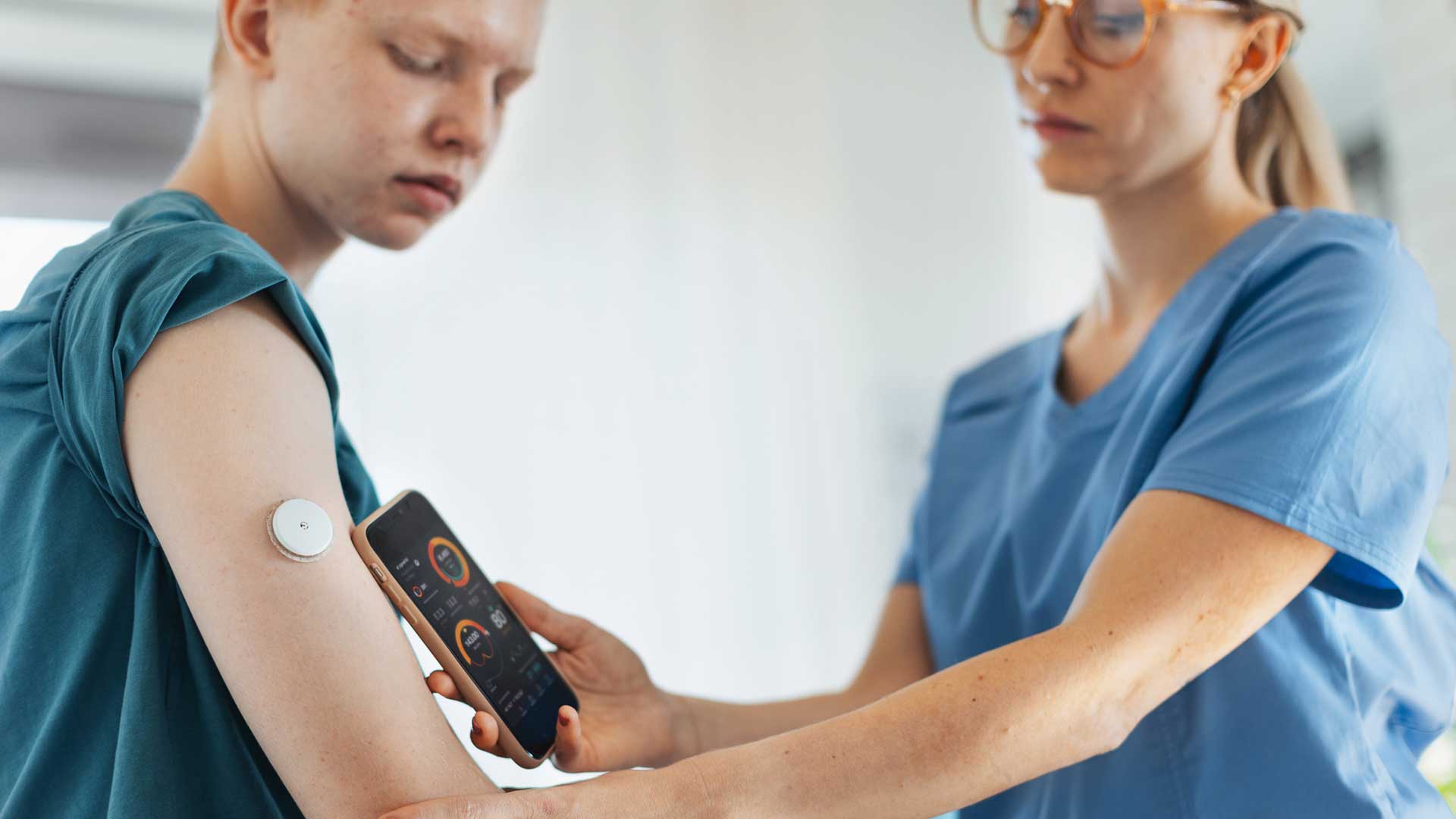Continuous Glucose Monitors (CGMs) are a medical technology used to monitor your child’s blood glucose levels on an ongoing basis. CGMs are commonly used to help manage glucose levels and reduce the risk of complications associated with abnormal blood glucose.
CGMs can be attached in different places which are usually chosen on a rotation to avoid skin rashes or infections from the continuous attachment of the CGM.
In children specifically, there may be a few places in which attaching a CGM is easier to access and more comfortable to wear daily. Let’s take a look at what these places are so you and your child can avoid having to remove the CGM earlier than needed because of skin reactions or lack of comfort.
How Do CGMs Work?
But first, how do CGMs work?
Let’s discuss the working mechanism of CGM devices in detail. CGM devices work by measuring glucose levels in the interstitial fluid that surrounds the body’s cells. The sensor in a CGM device usually consists of a small, flexible needle or filament. This small sensor is inserted just beneath the skin.
The needle of the sensor is connected to a transmitter, which is either attached to the body or worn separately. The transmitter sends data to a receiver or smartphone app, which displays the glucose data in real-time, providing parents with a continuous stream of information about their child’s glucose levels.
You’re probably familiarized with the traditional finger prick method for the measurement of blood glucose levels. The main difference between finger pricking and CGMs is the frequency of glucose measurements.
Finger pricking requires you to manually prick your child’s finger and test their blood glucose levels several times a day, while a CGM provides continuous glucose data without the need for finger pricking. Additionally, finger pricking provides a snapshot of glucose levels at a particular moment, while a CGM provides a more complete picture of glucose levels over time.
In terms of accuracy, glucose measurements of both methods are comparable. However, CGM devices are subject to errors and inaccuracies. So, parents should be aware that there can be variability between different CGM devices and individual sensors.
Finger pricking may be more accurate in some cases, particularly if the CGM sensor has been in place for a prolonged period or if there are issues with the sensor’s placement or calibration.
Overall, CGM devices offer a more convenient and comprehensive method of glucose monitoring for patients with diabetes and are an important tool in diabetes management. Check out our other blog post if you want more in-depth information about all things CGMs.
Best Places to Attach a CGM
Parents need to be aware that the best place to attach CGM devices may depend on several factors, including personal preference, skin sensitivity, body shape and size, and the type of CGM device being used.
Here are some common areas where CGM devices can be attached to children:
- Abdomen: This is a popular site for CGM attachment, as it provides easy access and is relatively comfortable.
- Upper arm: This site can be a good option for children who complain the attachment in the abdomen is uncomfortable or those who rotate the attachment site frequently. The device can also be concealed under clothing.
- Thigh: This site is another option for children who find the abdomen uncomfortable or want to rotate the attachment site.
- Upper buttocks: This site may be suitable when parents prefer a more concealed location for CGM devices on their child’s body or for children who move around frequently and don’t want to be restricted by a device on their abdomen or upper arm.
You should consider several factors when it comes to attaching a CGM device. Those factors are skin sensitivity, risk of infection, comfort, and visibility.
If your child has a part of their body where their skin is more sensitive or has some scarring, consider avoiding that place. Also, if your child is a bit older and worried about the visibility of their CGM, maybe consider less visible places like the upper buttock.
Overall, the choice of attachment site may vary depending on individual preferences and circumstances. It’s important to work closely with a healthcare professional to determine the best site for your child and to ensure that the CGM device is used safely and effectively.
Preparing to Attach a CGM
So how do you prepare to attach a CGM to your child’s body?
Before attaching a CGM device, it’s important to properly prepare both the skin and the device to reduce the risk of infection, skin reactions, or allergies.
Here are some tips for preparing the site and the device for attachment:
- Clean the skin: Use mild soap and water to clean the skin where you plan to attach the CGM device. Also, remove any oils or lotions, as they can interfere with adhesion.
- Dry the skin: After cleaning the skin, make sure the area is completely dry before attaching the device.
- Consider shaving the area: For some older children, shaving the area where the CGM device will be attached can help to ensure that the device adheres properly and is more comfortable.
- Skin preparation: Some CGM devices come with skin preparation materials, such as adhesive wipes or sprays, that can help improve adhesion and reduce the risk of skin irritation.
- Inspect the device: Check the CGM device before attaching it to make sure that the sensor and transmitter are properly attached and in good condition.
- Test for allergies: If your child has a history of skin allergies or reactions, consider doing a small patch test to check for allergic reactions to the device’s adhesive.
- Check the expiration date: Ensure that the CGM sensor is not expired before attaching it.
- Follow the manufacturer’s instructions: Make sure you follow the manufacturer’s instructions for attaching the device.
How to Attach a CGM?
It’s very important to know the proper technique for attaching a CGM device to a child’s body.
Here are the steps for attaching a device:
- Locate the attachment site
- Clean the attachment site
- Remove the adhesive backing
- Align the device
- Once the device is positioned correctly, apply gentle pressure to the adhesive surface to secure it to the skin.
- Start the device
In general, a CGM device should be removed if it becomes damaged or if there are signs of infection or skin irritation around the attachment site. It may also need to be removed if it’s interfering with daily activities, such as swimming or showering. Also, some children may need CGM devices to be temporarily removed for medical procedures, such as MRI scans, as the magnetic fields may interfere with the device’s sensors.
Parents can usually remove the CGM device themselves. However, it’s important to follow the manufacturer’s instructions carefully to avoid damaging the device or causing injury. In some cases, healthcare professionals may need to remove the device, particularly if it is embedded under the skin or if there are complications or issues with the device.
How Long Can You Wear a CGM?
The length of time that a CGM device can be worn varies depending on the manufacturer and the specific model. Here’s a brief overview of the wear time of the most common devices:
- Dexcom G6: The Dexcom G6 is designed to be worn for up to 10 days before it needs to be changed. The transmitter lasts for three months before it needs to be replaced.
- Dexcom G7: The Dexcom G7 is designed to be even smaller than the G6 and have a longer wear time. Dexcom has announced that the G7 sensor will have a 14-day wear period.
- FreeStyle Libre 2: The FreeStyle Libre 2 can be worn for up to 14 days.
- FreeStyle Libre 3: The FreeStyle Libre 3 has already been approved by FDA in the United States as well. It’s designed to be even smaller and more accurate than the FreeStyle Libre 2, with a thinner sensor but the same wear time i.e.14 days.
Remember to Change CGM Sites Every Now And Then
CGMs are an essential tool for children with type 1 diabetes to monitor their blood glucose levels. Proper attachment of the CGM device is important for accurate readings and minimizing the risk of complications, such as infections or allergic reactions.
Remember that the best place to attach a CGM device depends on the individual’s preferences and the device’s manufacturer’s recommendations. In general, the CGM sensor should be attached to an area that has adequate subcutaneous fat, such as the abdomen, back of the arm, or upper buttock.
It’s important to avoid areas with significant scarring, active insulin infusion sites, or skin rashes.
And if your child needs to change sites frequently, our app Gluroo can be a great tool for ensuring you keep track of which sites have been used lately, and help you properly rotate attachment places.
Gluroo can also help keep track of meals, exercises, insulin pump sites, and open insulin vials and it integrates with CGMs and insulin pumps so you and other caretakers can view your child’s real-time data remotely.
You can download Gluroo for free today.




